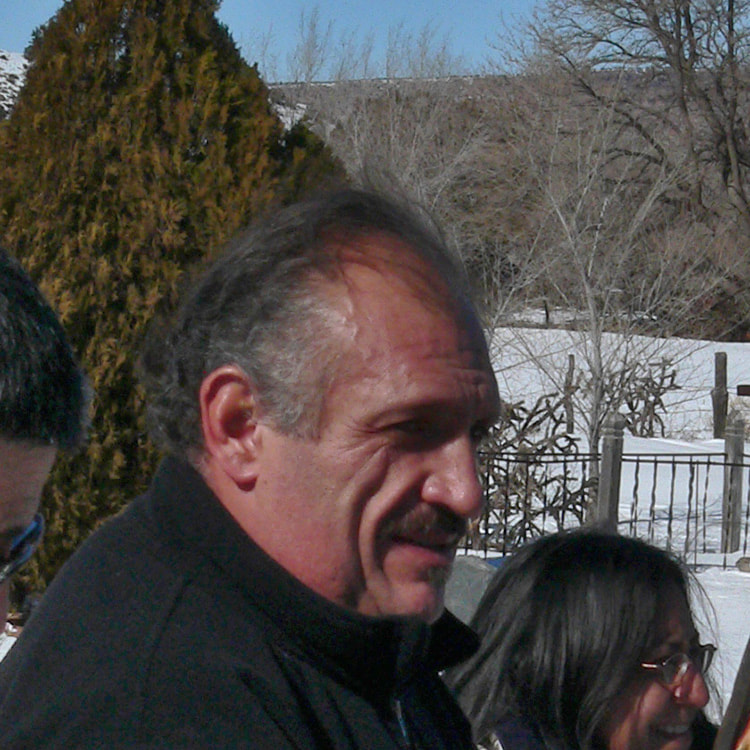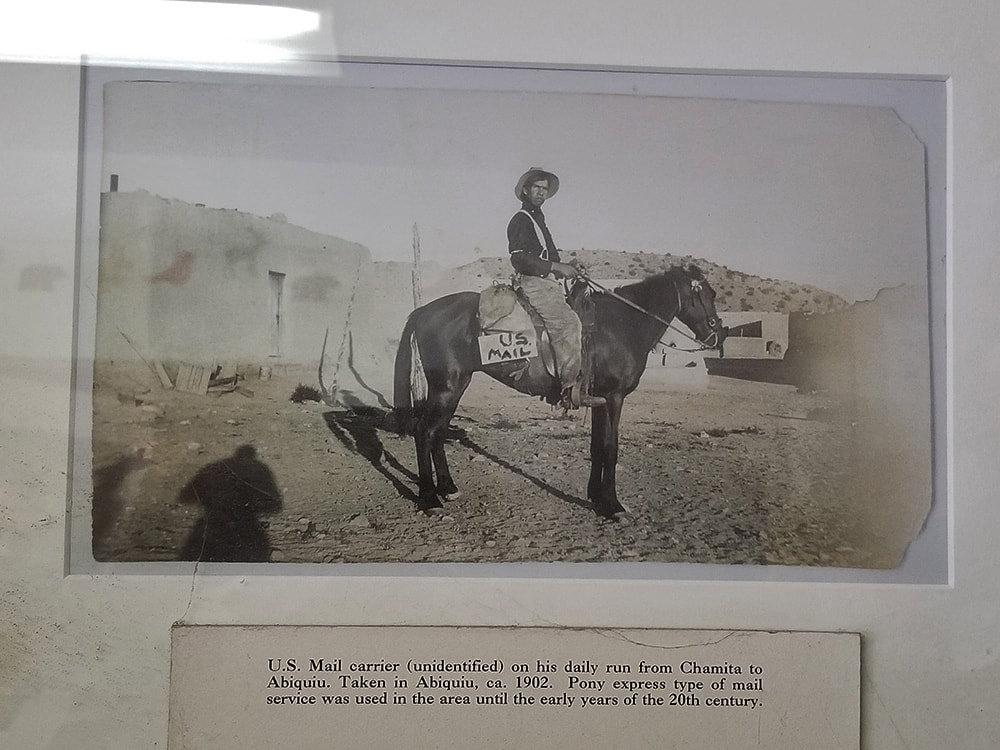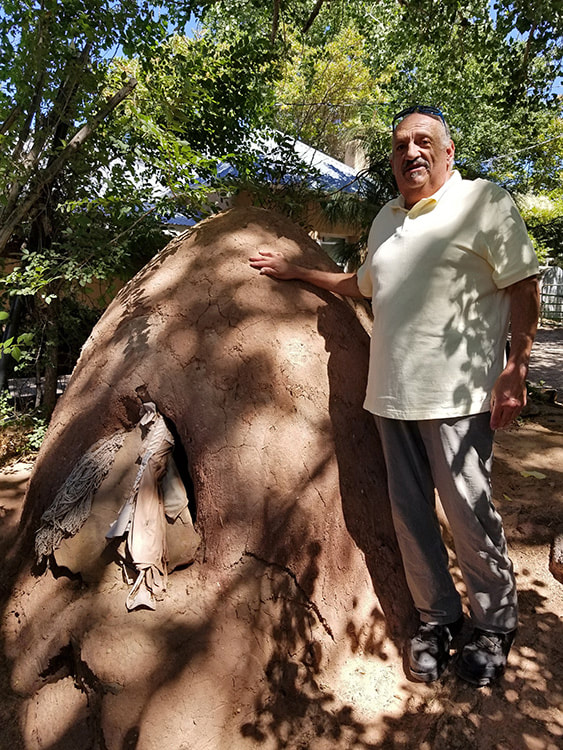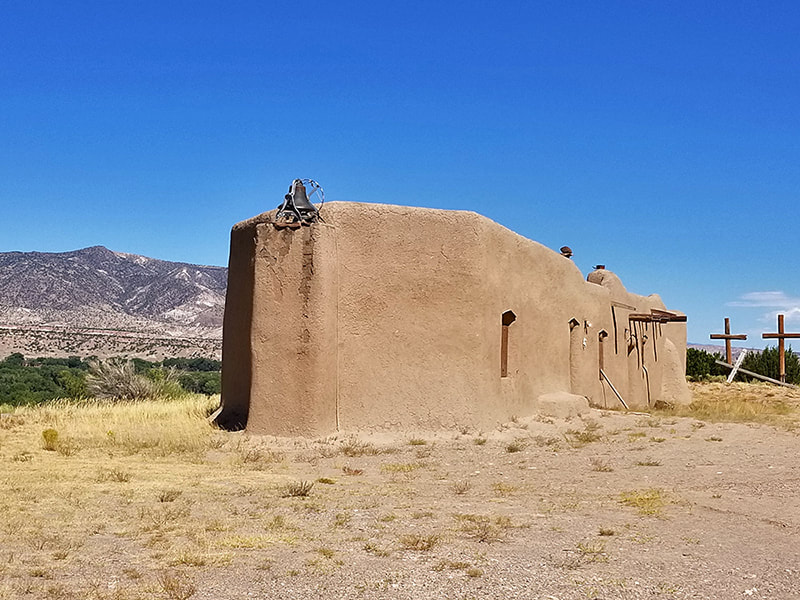|
An afternoon with Dexter Trujillo By Jessica Rath Not many people, myself included, would call their life beautiful, without reservation. Maybe after thinking about it for a while – yes, I agree, it IS beautiful. But often life throws frustrating and annoying stuff at us which dominates the way we feel and overshadows the beauty. When I met with Dexter Trujillo at the Abiquiú Library he totally convinced me that his life is indeed beautiful. And I learned that his life has its share of frustrating and annoying, even sad, events. However, these events don’t cast a pall on his basic outlook. Here is an example: in May, he visited his sister Margo who lives in Minnesota. While there, he did the 21-mile-long Walk to Mary – a pilgrimage to the National Shrine of our Lady of Champion in Wisconsin. Dexter had to explain: this is the only site in the United States where the Catholic church recognizes an apparition of Mary. She appeared to Sister Adele (or St. Adele) in 1859 and told her to teach the young children, often orphans. “There were 4,000 pilgrims, it was so beautiful. But it was freezing! But we made it; I don't know how we made it. We started at six in the morning. And it went until 5:30 pm. We had an ending mass at 5:30. But we almost froze! I just couldn't walk anymore. I could barely kneel, I couldn't even think! Maybe 20 years ago, yes, I could have done it. But now – I can do the pilgrimage from Abiquiú to Santa Rosa de Lima, but no more than that!” Dexter laughs. “It was like a blizzard! The whole way it rained down. The wind was awful and had the rain pour into your face. But it was beautiful. You know, 4000 people, youngsters and not not so young and average people in all kinds of walks of life and so beautiful that there's that devotion. We had an outdoor mass and it was packed. I wanted to get souvenirs but I couldn't even walk to the shop anymore. I walked in the church and prayed the rosary and then we went down into the crypt, where they have an image of the Blessed Mother. You know, the Peshtigo Fire (which happened the same day as the Great Chicago Fire) extended all the way to that place in Wisconsin right there. They say that Sister Adele got all the people on their knees, and they went on their knees around the chapel. And they had a wooden fence and the fire spread to just the wooden fence. It stopped right there. And all the people were unharmed. That’s how deep their faith was. So I'm glad I went and it was beautiful. It reminds me a lot of here too because we just had our annual Santa Rosa de Lima Fiesta.” I should point out here that I’m not affiliated with any organized religion, and in general, my views are rather dim on the subject. But Dexter’s sincerity and devotion, his genuine desire to help people and to make the world a better place, impressed me deeply. He dedicates every moment of his life to follow the teachings of his religion, the teachings of Jesus Christ, as well as he can. This is unusual and quite remarkable. U.S.Postal Service in 1902. The library has many historic photographs. Image credit: Jessica Rath Dexter showed me around the library, and then we went across the Plaza and entered the church of Santo Tomás el Apostol, Saint Thomas the Apostle. It was built around 1935. Here is an interesting anecdote from its early days: “The wealthy people lived towards the highway, the current highway. And the church was really the work of the hermanos and penitentes, they were doing all the backbreaking labor, also the women and children. Anyway, they found out that the pueblo was going to get the back end of the church. And the church was already four feet high. When the people realized that they were going to get the back of the church facing the pueblo, they came with their axes and with their plows and they plowed everything down. They said if we're getting the back of the church, then we don't want a church here in Abiquiú. So anyway, what happened was that the people said we will have our church but we want the face toward the pueblo, to our side. Because they were doing all the work.” “There's pictures at the library of the old church. The only reason they had to destroy that church was because the adobes weren't tight together. So the walls started to separate.” We spent some time in the church, and Dexter pointed out various paintings, images, and weavings. People with a sick family member would make a promise: they’d weave a tapestry if the person got well again. There’s a lot of local history embedded in the church, and the knowledge of this cultural tradition, of the history going back several generations, enriches Dexter’s life and gives it meaning and significance. After our visit to the church Dexter invites me to have a look at his garden. “In my garden I grow my own chile, my own vegetables, tomatoes, pinto beans, I plant a little bit of everything, even Zinnias. We have apricots, apples, grapes, plums – you name it. We have our apricot tree that’s over 300 years old. It has sweet almonds, they say that if you eat the almonds of that tree you won’t get cancer.” First, though, I want to admire the big horno that he built himself. The bricks are made from the soil around Abiquiú. And then we visit the chickens. Dexter opens a gate to let them out of their coop; they happily run around and enjoy their freedom. At night they’ll return to their shed to be safe from coyotes and racoons. We walk through the vegetable garden to go to the almond tree, and Dexter picks a few ripe tomatoes and little round cucumbers for me. It is obvious that his life is strongly connected to the soil, to the natural spring that flows close by, to the apple trees that his grandfather planted, and of course to the magnificent apricot tree. “When my grandpa was alive, he told us that he would ask his great-grandpa how old this tree was. And his great-grandpa would say that it was already a tree when he was a little boy. So it must be at least 300 years old.” As somebody who has changed locations all her life, I ponder: what must it feel to have deep roots to one’s past? Our last stop is the Morada de Alto, the true center of Dexter’s life. I always thought that los Hermanos Penitentes was a secretive society who don’t welcome any outsiders, but this is completely wrong, according to Dexter. He calls them sacred places where people should feel at home, that unite people, where everybody is cared for. He compares them to kivas: a space for gatherings. When the land here still belonged to Mexico, many of the smaller settlements and pueblos were without a priest. It was the laity, the hermanos penitentes, the brothers that kept Catholicism alive. “ The Morada is like a retreat center, a house of prayer. It’s for everybody, you don’t have to be Catholic to attend. But this is where we learn about our Catholicism. This is where we've learned the doctrine of the Church. This is where we really dissect the information and pass it along to the community as best as we know how. This is really laity. A lot of people think that this is where the priests lived, or this is where the priests recite, and it's not, it’s laity. It's both men and women, we get together and we pray every Friday throughout the year, every second Friday here. This is called La Morada D’Alto. It is dedicated to Nuestra Señora Santa Dolores which means the house of Our Lady of Sorrows.” It was deeply touching to meet somebody so open, so ready to share some aspects of his life with a stranger. His long practice of serving the community, of helping other people, of dedicating his life to creating a peaceful and better world gives him a presence that one can feel strongly. Thank you, Dexter, for a beautiful afternoon.
8 Comments
Iren Schio
9/22/2023 08:16:21 pm
Wonderful interview with Dexter Trujillo Jessica , thank you . Dexter truly is a Blessing for all the people that encounter him .
Reply
Jessica
9/24/2023 04:07:46 pm
I'm glad you liked it, Iren. Yes, Dexter is a very special person -- I felt that he is the sould of Abiquiú :)
Reply
9/23/2023 09:24:00 am
Such a wonderful article. Dexter gave my son and I a special tour of the Morada 20 years ago. It was a very moving experience walking into such a sacred space.
Reply
Jessica
9/24/2023 04:09:25 pm
Thank you, Walter! What a lovely memory., thanks for sharing.
Reply
Judith Williams
9/25/2023 06:43:15 pm
What an interesting article. I have lived in Abiquiu for almost 20 years and have met Dexter, know his family and have done many paintings of the morada. Even so I learned a lot from reading this so thanks
Reply
J. Suris
9/25/2023 09:06:40 pm
Thank you Jessica. Dexter is indeed a treasure for Abiquiu and thank you for honoring him with this article reminding us of his special presence among us.
Reply
Grace Chow
9/29/2023 06:27:35 am
My husband and I were in Abiquiu some years ago- we went to New Mexico coz I was interested in Georgia Okeefe’s works and her life in the Ghost Ranch, etc. I love New Mexico, I love the landscapes, the adobes, the history, cultures, etc. Hope I can go back there again..
Reply
9/30/2023 04:04:54 pm
Dexter is a New Mexico cultural celebrity.....Abiquiu should be a cultural, historical preservation, but too bad New Mexico does not know it!
Reply
Your comment will be posted after it is approved.
Leave a Reply. |
Submit your ideas for local feature articles
Profiles Gardening Recipes Observations Birding Essays Hiking AuthorsYou! Archives
September 2025
Categories
All
|








 RSS Feed
RSS Feed